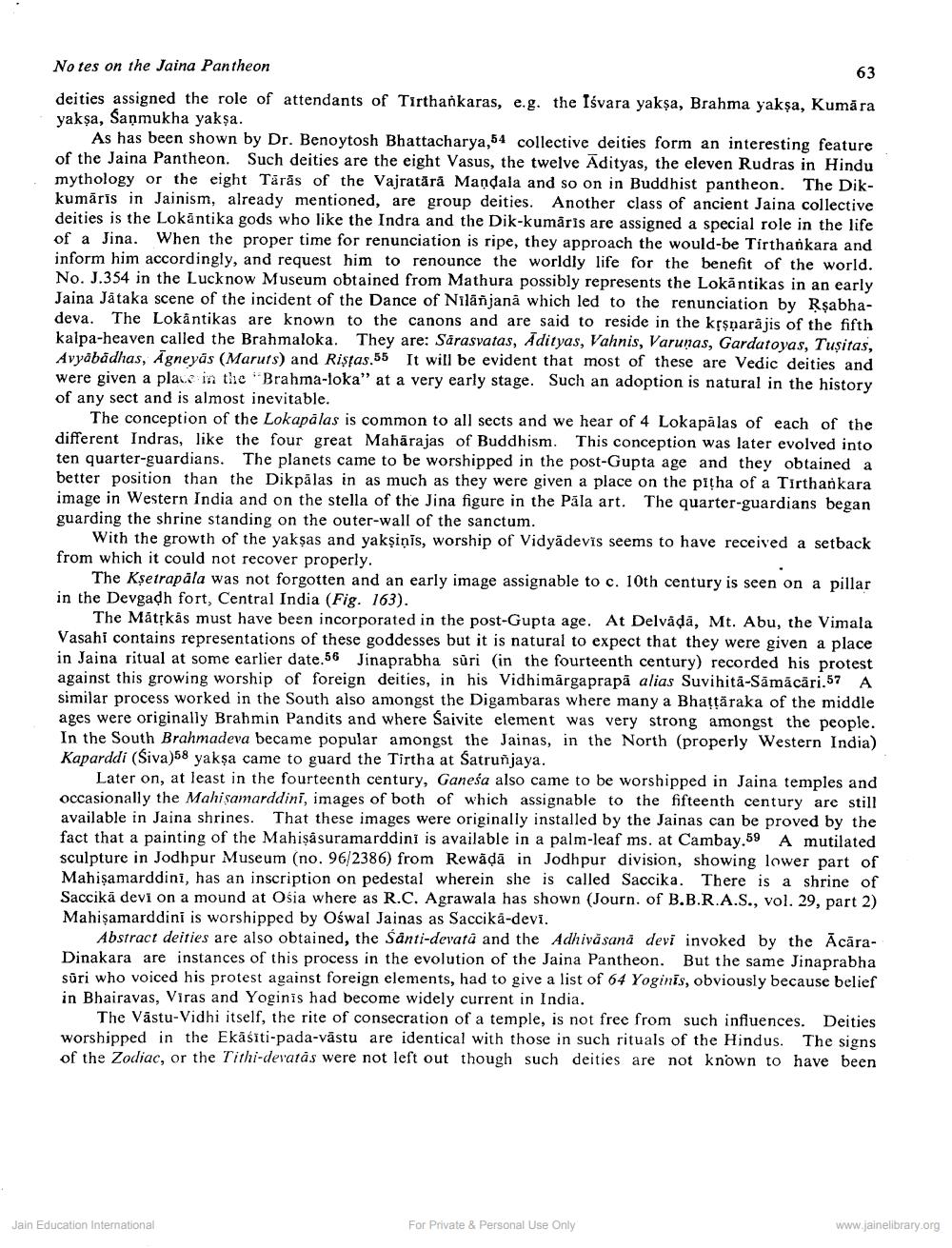________________
No tes on the Jaina Pantheon
63
deities assigned the role of attendants of Tirthankaras, e.g. the Iśvara yakşa, Brahma yakşa, Kumāra yakşa, Saņmukha yakşa.
As has been shown by Dr. Benoytosh Bhattacharya,54 collective deities form an interesting feature of the Jaina Pantheon. Such deities are the eight Vasus, the twelve Adityas, the eleven Rudras in Hindu mythology or the eight Tärās of the Vajratără Mandala and so on in Buddhist pantheon. The Dikkumaris in Jainism, already mentioned, are group deities. Another class of ancient Jaina collective deities is the Lokäntika gods who like the Indra and the Dik-kumaris are assigned a special role in the life of a Jina. When the proper time for renunciation is ripe, they approach the would-be Tirthankara and inform him accordingly, and request him to renounce the worldly life for the benefit of the world. No. J.354 in the Lucknow Museum obtained from Mathura possibly represents the Lokantikas in an early Jaina Jätaka scene of the incident of the Dance of Nilāñjana which led to the renunciation by Rşabhadeva. The Lokantikas are known to the canons and are said to reside in the krsparājis of the fifth kalpa-heaven called the Brahmaloka. They are: Sarasvatas, Adityas, Vahnis, Varunas, Gardatoyas, Tusitas, Avyåbädhas, Āgneyas (Maruts) and Ristas 55 It will be evident that most of these are Vedic deities and were given a place in the Brahma-loka" at a very early stage. Such an adoption is natural in the history of any sect and is almost inevitable.
The conception of the Lokapalas is common to all sects and we hear of 4 Lokapālas of each of the different Indras, like the four great Maharajas of Buddhism. This conception was later evolved into ten quarter-guardians. The planets came to be worshipped in the post-Gupta age and they obtained a better position than the Dik pālas in as much as they were given a place on the pitha of a Tirthankara image in Western India and on the stella of the Jina figure in the Pala art. The quarter-guardians began guarding the shrine standing on the outer-wall of the sanctum
With the growth of the yakşas and yakşiņis, worship of Vidyādevis seems to have received a setback from which it could not recover properly.
The Kșetrapala was not forgotten and an early image assignable to c. 10th century is seen on a pillar in the Devgadh fort, Central India (Fig. 163).
The Mătrkas must have been incorporated in the post-Gupta age. At Delvådā, Mt. Abu, the Vimala Vasahi contains representations of these goddesses but it is natural to expect that they were given a place in Jaina ritual at some earlier date.56 Jinaprabha súri (in the fourteenth century) recorded his protest against this growing worship of foreign deities, in his Vidhimärgaprapa alias Suvihitä-Sämäcäri.57 A similar process worked in the South also amongst the Digambaras where many a Bhattāraka of the middle ages were originally Brahmin Pandits and where Saivite element was very strong amongst the people. In the South Brahmadeva became popular amongst the Jainas, in the North (properly Western India) Kaparddi (Siva)58 yakşa came to guard the Tirtha at Satrunjaya.
Later on, at least in the fourteenth century, Ganesa also came to be worshipped in Jaina temples and occasionally the Mahi samarddini, images of both of which assignable to the fifteenth century are still available in Jaina shrines. That these images were originally installed by the Jainas can be proved by the fact that a painting of the Mahişåsuramarddini is available in a palm-leaf ms. at Cambay.59A mutilated sculpture in Jodhpur Museum (no. 96/2386) from Rewādā in Jodhpur division, showing lower part of Mahisamarddini, has an inscription on pedestal wherein she is called Saccika. There is a shrine of Saccikä devi on a mound at Ośia where as R.C. Agrawala has shown (Journ. of B.B.R.A.S., vol. 29, part 2) Mahisamarddini is worshipped by Ośwal Jainas as Saccika-devi.
Abstract deities are also obtained, the Santi-devata and the Adhiva sana devi invoked by the ĀcāraDinakara are instances of this process in the evolution of the Jaina Pantheon. But the same Jinaprabha sūri who voiced his protest against foreign elements, had to give a list of 64 Yoginis, obviously because belief in Bhairavas, Viras and Yoginis had become widely current in India.
The Vāstu-Vidhi itself, the rite of consecration of a temple, is not free from such influences. Deities worshipped in the Ekāśiti-pada-vāstu are identical with those in such rituals of the Hindus. The signs of the Zodiac, or the Tithi-devatás were not left out though such deities are not known to have been
Jain Education International
For Private & Personal Use Only
www.jainelibrary.org




